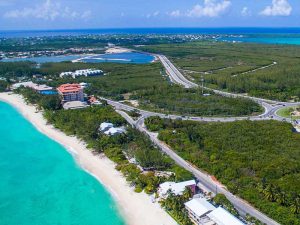Home » Information » Caymanian Culture
Caymanian Culture and Society
Describing Caymanian culture can sometimes be a little bit like picking up mercury as it is a constantly shifting dynamic.
From the early settlers to the modern work permit holders, Cayman has been influenced over the last 500 years by many different traditions. The country does, however, have a distinctive society that sets it apart from the rest of the Caribbean — hence the saying that Cayman is an island in the Caribbean rather than a Caribbean island. The Caymanian people work hard to maintain their identity while embracing modern development wholeheartedly.
The first historically recorded sighting of the Cayman Islands recorded was made in 1503 by Christopher Colombus who named the islands Las Tortugas-the turtles. And even though the islands eventually were named for the small marine crocodile once found in local waters, it was the abundance of the turtle that was to play a crucial roll in the story and culture of Cayman.
The Caymanian society has always been and still is one based around maritime traditions. The ocean and its bounty have shaped the islands’ destiny and created a culture that is deeply connected to the water. The national motto “He hath founded it upon the seas” is a true reflection of Caymanian culture, and even after the growth of a successful financial services industry, the ocean is still fundamental to the local culture.
Can’t find the information you are looking for, use the
Cayman Islands GPT
Related Topics
Cayman’s maritime traditions began with the earlier settlers who became consummate fishermen and traders. From the Catboat regattas and fishing tournaments to the Cayman Islands Shipping Registry and cruise ship tourism, the sea is as central to Caymanian life today as it has been throughout history. No trip to Cayman is complete without venturing onto the water with one of Cayman’s experienced boat captains, either merely to see the sights or to catch yourself a wahoo.
The sea has also influenced the local food enormously. While over-fishing has had an impact on fish stocks in Cayman as it has around the world, lobster, turtle and conch remain staples in the local diet. Turtle is now farmed in order to fulfill demand as it cannot be taken from the sea, and other marine life is protected through fishing seasons and restrictions on who can take what, as well as when and where. As Cayman’s culinary culture evolves into a high-end gastronomic experience, it still draws on traditional ingredients and recipes, which are adapted by the growing number of top class chefs that are working in the ever more impressive restaurants opening on island. From Blue, the 5-star restaurant at the Ritz Carlton, to the local East End fish fry, the ocean is as important to Cayman’s menus as it ever was.
As skilled boat and later rope makers, Caymanians have always been competent crafters. The silver thatch rope made here in days gone by was once highly prized as it didn’t rot in salt water – a crucial characteristic for boat lines. Although today most boats are tied up with imported synthetic ropes, the skills required to make the rope of old, as well as the thatched roofs, baskets, hats and many other everyday items, are being preserved by organizations such as Cayman Traditional Arts and the Cayman National Cultural Foundation. Through demonstrations, workshops, school visits and summer camps, many young people in Cayman have learned the traditional crafts of their forefathers. However, there are many Caymanians who are also carving out a new artistic culture for the islands.
The number of artists living and working in Cayman is significant for such a small population of around 55,000. This has given rise to a vibrant artistic community and a network of interesting galleries and places where local artists show their work. The Native Sons, a group of artists all born in the islands, are striving to promote modern Caymanian art as a serious movement. Once again, the sea has had a significant influence on much of the art produced in Cayman, but these artists are seeking to push the boundaries of how local art is defined and many of them are producing modern, abstract pieces that are finding their way into collections the world over.
Storytelling and the islands’ musical history are also being kept alive with a number of kitchen bands who perform regularly, but also through annual cultural festivals. Taking place towards year end, Gimme Story is one of Cayman’s best loved festivals, which as well as being entertaining keeps alive a tradition of storytelling that goes back hundreds of years. The Jazz Fest is a reflection on how Caymanian culture is changing and offers a rich diversity of music. While the festival usually features a star-studied line up of international artists, it also showcases many of Cayman’s talented local musicians.
Cayfest is a veritable smorgasbord of cultural activity that takes place in the spring and presents a diverse range of music and arts, which mixes up the old with the new and gives a definitive impression of Cayman’s arts scene. The country boasts a long list of other events throughout the year that celebrate many different aspects of modern Caymanian culture, from food to powerboat racing.
The Caymanian people have managed to maintain a delicate balance between modernity and tradition. While some 70 percent of the population has internet access and most have mobile phones and satellite television, you don’t have to look far to find a fisherman selling his wares and keen to tell tales of the sea. Caymanians have also preserved their quiet Christian morality and their understated sense of humour and kindness. Sunday remains a special and sacred day, when dancing and live music are not permitted in bars. People attend church regularly and many make significant voluntary contributions with time and finance to their community. The sense of family, heritage and national pride is steadfast. At the same time, they have created one of the world’s largest and most successful financial service centres.
There are currently numerous debates, as with many other countries, about how the culture is being undermined by the incredible influx of foreign workers. There are some 102 different nationalities now living and working in the islands and Caymanians make only around 50 percent of the population. However, the islands still retain a distinctive Caymanian flavor that many people are working hard to preserve.
For more details on cultural events throughout the year contact:
Cayman Traditional Arts
Email: rockyshore@weststartv.com
Tel: 345-926-0119/925-5102
Cayman National Cultural Foundation
Email: cncf@candw.ky
Tel: 345 949-5477
Cayman Islands National Museum
Email: museum@candw.ky
Tel: 345 949-8368
Cayman National Trust
Email: info@nationaltrust.org.ky
Tel: 345 949 0121






